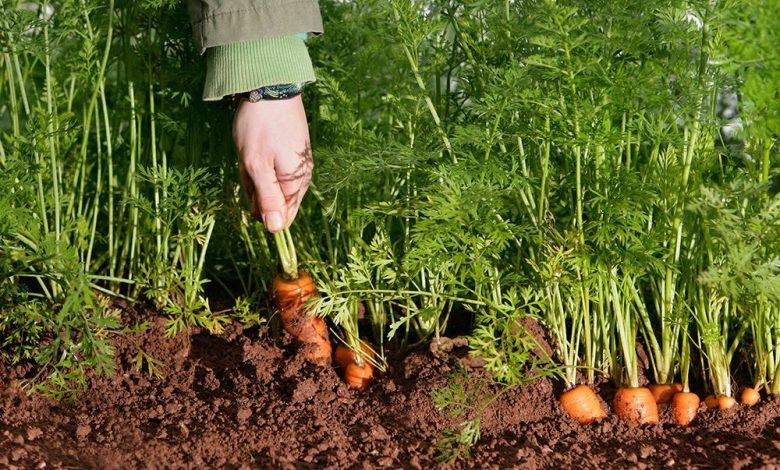Carrot Cultivation Business in India – A Complete Guide
Carrot Cultivation Business in India

Carrot is an annual and biannual crop that comes from the Umbelliferae family. The native country of this crop is Europe. The carrot is one of the most significant sources of Vitamin A. Therefore, Indian farmers grow carrots majorly. The prime producers of carrots are Haryana, Andhra Pradesh, Karnataka, Punjab and Uttar Pradesh in India.
Climate for Carrot Cultivation
We can grow carrots from 7 to 23°C temperature. And during sowing time, it must be from 18 to 23°C. Moreover, the rainfall for carrot cultivation is suitable from 75 to 100cm. Finally, we should harvest the crop when the temperature lies between 20 to 25°C. So, if we take care of these requirements, we will definitely get maximum results.
Soil for Carrot Cultivation
For carrot cultivation, deep, loose, loamy soils are suitable. Also, it helps in good root development. On the other hand, heavy and too loose soils are not ideal for carrot cultivation. Also, the soil pH must be between 5.5 to 7. The ground can be perfect for carrot farming when we use adequate machines like Farmtrac 45 and others.
Popular Varieties
PC 34: The variety has a red colour with dark green leaves. And the root length is 25 cm, and the diameter is 3.15 cm. Moreover, this variety matures after 90 days of sowing. Therefore, the average yield of this variety is 204 QTL/acre.
Punjab Black beauty: The roots of this variety are purple-black with dark green leaves. It is a good source of anthocyanins and phenols, which protect against cancer. Moreover, the variety matures 93 days after sowing. The average yield of this variety is 196 QTL/acre. We can use it for salad, juice, pickle and Kanji.
Punjab Carrot Red: The average yield of this variety is 230 QTL/acre.
Pusa Kesar: It is a red coloured carrot variety developed in New Delhi by IARI. The variety matures from 90 to 110 days after sowing. And the average yield of this variety is 120 QTL/acre.
Pusa Meghali: The variety has an orange colour. And it is developed by IARI in New Delhi. So you can get a yield of 100-120 QTL/acre from this variety.
New Kuroda: It is a hybrid variety, which is suitable for plain as well as hills.
Land Preparation
You have to thoroughly plough the land to make it weed and clods free. After that, you should apply decomposed farmyard manure at 10 tons/acre. Also, you should mix it well with the soil. Don’t use undecomposed or free cow dung because it can lead to forking of fleshy roots. Land preparation can be easier with excellent machines like Farmtrac 60 and others.
Sowing
The best time for sowing local desi varieties is from August to September. And for European types of carrots, the ideal time for sowing is from October to November. Moreover, we should use the row space of 45 cm and plant to plant space of 7.5 cm. And 1.5 cm sowing depth is sufficient for it. Moreover, you can use the dibbling method as well as the broadcasting method for sowing carrots.
Seed
4-5 kg of seeds are sufficient for sowing in one acre of land. Before planting seeds, soak them in water for 12-24 hours. It will help to push the germination.
Fertilisers
You can use Nitrogen@25kg, Phosphorus@12kg and Potash@30kg per acre of land along with the well-decomposed cow dung at the time of sowing. Potash is a vital thing for good roots’ development.
Weed Control
You should apply weeding and hoeing to keep the field weed-free. Also, it reduces weed growth in the area and provides soil aeration.
Irrigation
Apply first irrigation after sowing. It will help in better germination. After that, you should apply the remaining irrigations depending upon the soil and climate conditions. It can be at an interval of 6 to 7 days in summer and 10 to 12 days in winter. Furthermore, carrot cultivation needs four to five irrigations during the season. However, do not irrigate the field excessively, resulting in a misshape of roots and extra hair growth. Lastly, you should stop irrigation 2 to 3 weeks before harvesting. It leads to an increased sweetness and flavour of carrots.
Plant Protection
You have to protect the carrot plant from several diseases and pests. Following are some of the pests and diseases of carrots.
Nematodes: Apply neem cake @ 0.5ton / acre at the time of sowing
Leaf spot: Spray of Mancozeb @ 2gm / Litre of water
Harvesting
Carrots can be harvested after 90 to 100 days of sowing. After that, it depends upon the varieties. Moreover, we can uproot the plant in manual harvesting. When harvesting is done, remove the green top from the carrots and wash with water.
Post Harvest
After harvesting, you should grade the carrots according to size and then pack them in gunny bags or baskets. Now the product is ready to market.
For more details regarding farming and others, stay with us.




